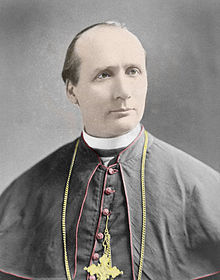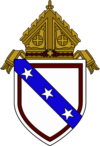John J. Keane (bishop)
Most Reverend John Joseph Keane, DD | |
|---|---|
| Archbishop of Dubuque | |
 | |
| Church | Roman Catholic Church |
| Appointed | July 24, 1900 |
| Term ended | April 28, 1911 |
| Predecessor | John Hennessey |
| Successor | James John Keane |
| Orders | |
| Ordination | July 2, 1866 by Martin John Spalding |
| Consecration | August 25, 1878 by James Gibbons |
| Personal details | |
| Born | September 12, 1839 Ballyshannon, County Donegal, United Kingdom of Great Britain and Ireland |
| Died | June 22, 1918 (aged 78) Dubuque, Iowa, USA |
| Previous post(s) | Bishop of Richmond (1878–1888) Rector of Catholic University (1886–1896) Titular Archbishop of Damascus (1897–1900) |
John Joseph Keane (September 12, 1839 – June 22, 1918) was an American Roman Catholic archbishop in the late 19th and early 20th century.
Early Life & Ministry[]
Keane was born in Ballyshannon, County Donegal, Ireland, to Hugh and Fannnie (Connolly) Keane. He was one of five children, and the family immigrated to the United States when he was seven years old. He was educated at Saint Charles College, Ellicott City, Maryland, and at Saint Mary's Seminary, Baltimore.[1] On July 2, 1866 he was ordained a priest for the Archdiocese of Baltimore by Archbishop Martin John Spalding and was made curate of St. Patrick's Church in Washington, D.C.,[1] where he spent 12 years. He helped form both the Catholic Total Abstinence Union of America and the Catholic Young Men's National Union[1] in 1872, and the Carroll Society in 1873.[2] He also established the Tabenacle Society in Washington that worked among poor churches throughout the United States.[3]
Bishop of Richmond[]
On March 28, 1878 Pope Leo XIII appointed Keane as the fifth Bishop of Richmond when he was 38 years old. He was consecrated bishop on August 25, 1878 by Archbishop James Gibbons of Baltimore, who was his predecessor in Richmond. Bishops John Joseph Kain of Wheeling and Thomas Patrick Roger Foley of Chicago, were the principal co-consecrators.[4] He established the Confraternity of the Holy Ghost in the diocese,[1] and published A Sodality Manual for the Use of the Servants of the Holy Ghost in 1880. Despite opposition, he founded schools and churches for African-Americans. He lectured before Protestant groups throughout the diocese to lessen prejudice against the church. In 1884 he attended the Third Plenary Council of Baltimore. The following May he was appointed by the Council to the committee to establish a Catholic university in the United States.
The Catholic University of America[]
Bishop Keane was appointed as the first rector of The Catholic University of America, Washington, D.C., in 1886 while he continued as Bishop of Richmond. On August 12, 1888 he was relieved of his responsibilities in Richmond and named Titular Bishop of Iasus so that he could focus his attention on establishing the new school.
He soon gained a reputation as an administrator and an orator who was widely quoted in the press.[2] At the same time he became aligned with the more progressive wing of the hierarchy because of the stances he took. He advocated for the Knights of Labor, took part in the Cahenslyism controversy, the quick Americanization of immigrants, the full representation of the Catholic Church at the Parliament of the World's Religions in Chicago and his positions on the school question. His democratic and liberal policies made him enemies with more conservative members of the U.S. Hierarchy and those at the Holy See, whence there came in 1896 a request for his resignation as rector.[1]
Ordination history of John J. Keane | |||||||||||
|---|---|---|---|---|---|---|---|---|---|---|---|
| |||||||||||
| |||||||||||
Rome[]
On January 29, 1897 Pope Leo XIII named him the Titular Archbishop of Damascus. He spent the years 1897 to 1899 as canon of St. John Lateran, Assistant at the Pontifical Throne, and counsellor to the Propaganda.[1] He lived in two rooms at the Pontifical Canadian College. He was attacked during the Americanism controversy that began to sweep through Europe "as a rationalist, throwing all dogma over to modern ideas."[2] He fought, and won, the battle to clear his name. In 1899 he was relieved of his responsibilities in Rome to raise funds for Catholic University, which was facing financial difficulties.
Archbishop of Dubuque[]
On July 24, 1900 Pope Leo XIII appointed Archbishop Keane as the fourth bishop and second archbishop of Dubuque. He once again took a prominent part in the Catholic Young Men's National Union and in the Total Abstinence Union of North America, and lectured widely on temperance, education and American institutions.[1] He encouraged postgraduate courses and ongoing education for priests, and doubled the faculty and buildings of St. Joseph's (now Loras) College. Twelve academies for girls and two for boys were constructed in the archdiocese.
On January 15, 1902 the Diocese of Sioux City was established from the western half of the archdiocese. His friend and associate at Catholic University, the Rev. Philip Joseph Garrigan, was appointed Sioux City's first bishop. The current boundaries of the archdiocese would not be established until 1911 after his resignation.
He served as archbishop until poor health forced him to request an auxiliary bishop or a coadjutor. No such appointment was made and he submitted his resignation instead. It was accepted by Pope Pius X on April 28, 1911, and he was named Titular Archbishop of Cius. He resided in the cathedral rectory in Dubuque until his death in 1918. Following his death Keane was buried at Mount Olivet Cemetery in nearby Key West.
Archbishop Keane was succeeded by Bishop James John Keane of Cheyenne. Even though both men had the same last name, they were not related. Local citizens have also drawn comparisons between the two men. John Keane was known as "Sugar" due to his kind and generous nature. James Keane was nicknamed as "Hickory" due to his stern personality.
A selection from his writings and addresses was edited by Maurice Francis Egan under the title Onward and Upward: A Year Book (Baltimore, 1902).[1]
References[]
- ^ Jump up to: a b c d e f g h One or more of the preceding sentences incorporates text from a publication now in the public domain: Chisholm, Hugh, ed. (1911). "Keane, John Joseph". Encyclopædia Britannica. 15 (11th ed.). Cambridge University Press. pp. 706–707.
- ^ Jump up to: a b c Ahern, P.H. Keane, John Joseph New Catholic Encyclopedia, vol VIII (New York: McGraw-Hill, 1967) 139.
- ^ http://www.encyclopediadubuque.org/index.php?title=KEANE%2C_John_J.
- ^ "Archbishop John Joseph Keane". Catholic-Hierarchy.org. David M. Cheney. Retrieved 21 January 2015.
Sources[]
- Ahern, Patrick Henry, The Life of John J. Keane: Educator and Archbishop, 1839–1918. Bruce Publishing Company, Milwaukee (1955)
- Ahern, Patrick Henry, The Catholic University of America: the Rectorship of John J. Keane. The Catholic University of America Press, Washington, D.C. (1948)
- Biography in "Historic Images of the Catholic Universities of America"
- 1839 births
- 1918 deaths
- Roman Catholic bishops of Richmond
- American Roman Catholic clergy of Irish descent
- Irish emigrants to the United States (before 1923)
- St. Charles College alumni
- St. Mary's Seminary and University alumni
- Harvard University staff
- Presidents of the Catholic University of America
- 19th-century Roman Catholic bishops in the United States
- 20th-century Roman Catholic archbishops in the United States
- Roman Catholic archbishops of Dubuque
- People from Ballyshannon
- People from Washington, D.C.
- Burials in Iowa



